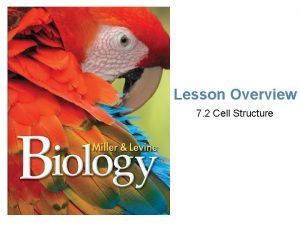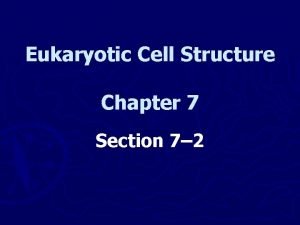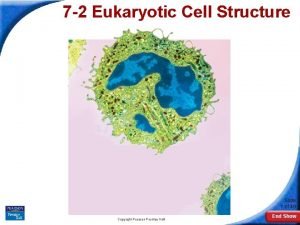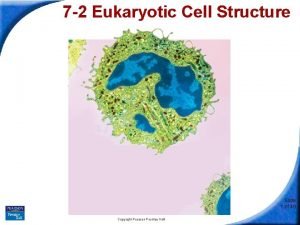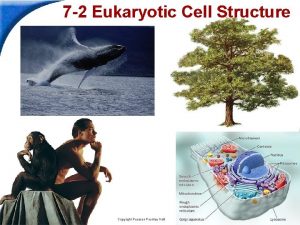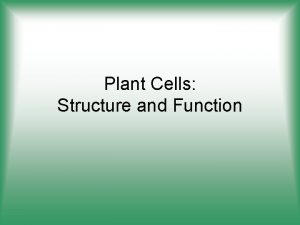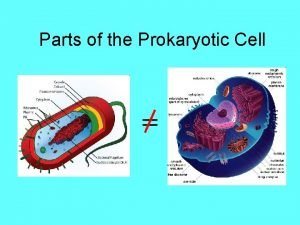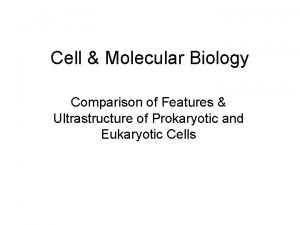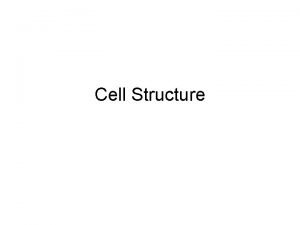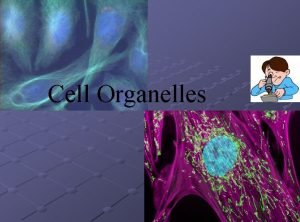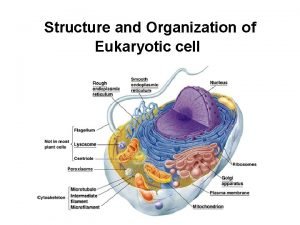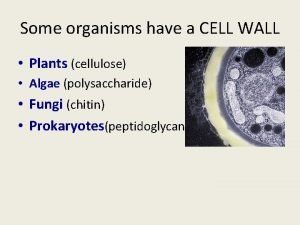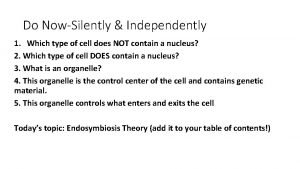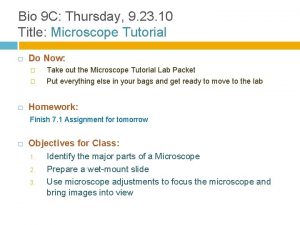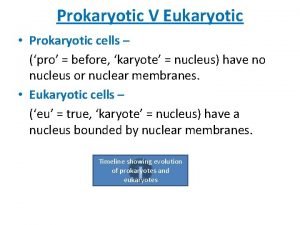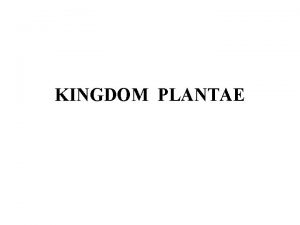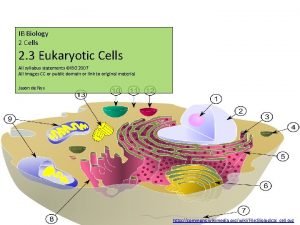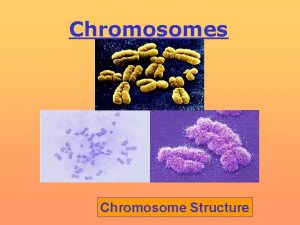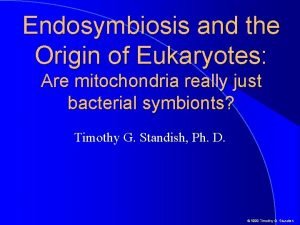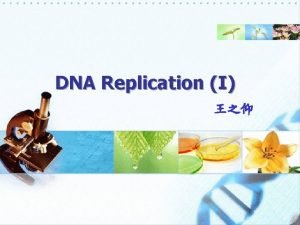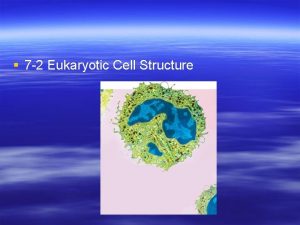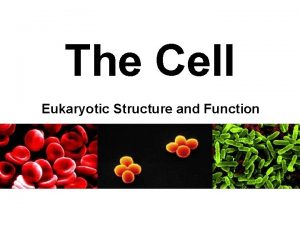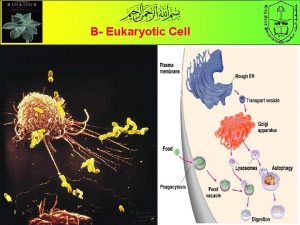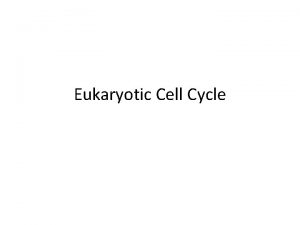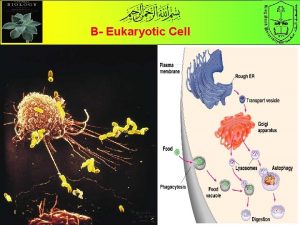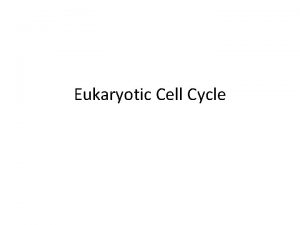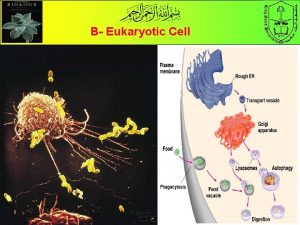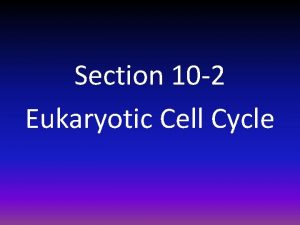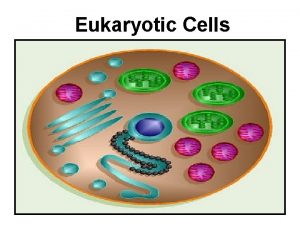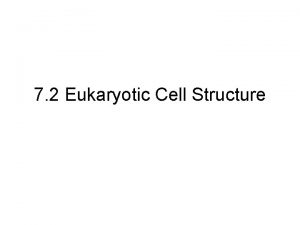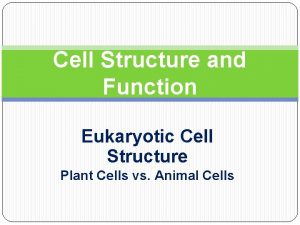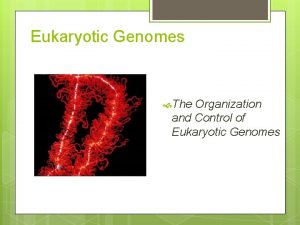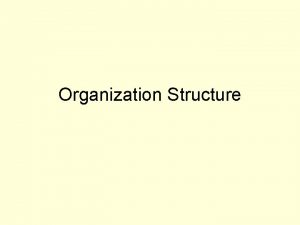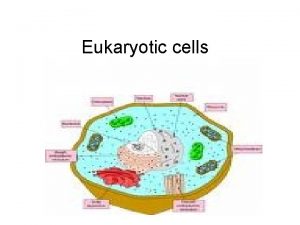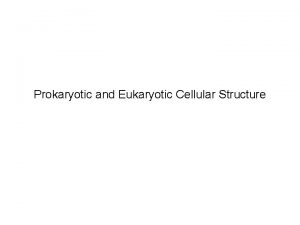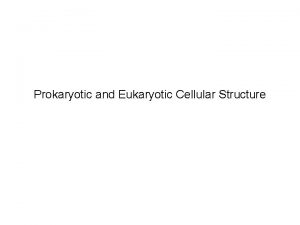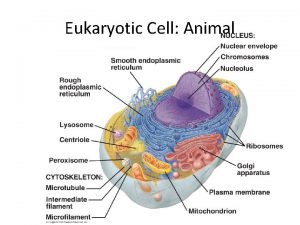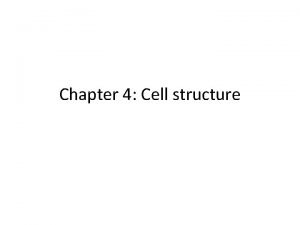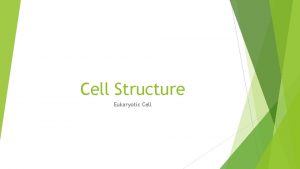7 2 Cell Structure Cell Organization The eukaryotic





























- Slides: 29

7. 2 Cell Structure

Cell Organization • The eukaryotic cell can be divided into two major parts: the nucleus and the cytoplasm. • The cytoplasm is the fluid portion of the cell outside the nucleus. • Prokaryotic cells have cytoplasm even though they do not have a nucleus.

Comparing the Cell to a Factory • The eukaryotic cell is much like a living version of a modern factory. • The different organelles of the cell can be compared to the specialized machines and assembly lines of the factory. • Organelles are the structures (“little organs”) that have specialized functions in eukaryotic cells.

The Nucleus • The nucleus is a large membrane-enclosed structure that contains genetic material in the form of DNA along with the coded instructions for making proteins and other molecules. • Controls many of the cell’s activities (like the main office controls a factory) • Prokaryotic cells do NOT have a nucleus but do contain DNA

The Nucleus • The nucleus is surrounded by a nuclear envelope composed of two membranes.

The Nucleus • The nuclear envelope is dotted with thousands of nuclear pores, which allow material to move into and out of the nucleus (like messages, instructions, and blueprints moving in and out of the main office of a factory).

Vacuoles and Vesicles • Many cells contain large, saclike, membrane-enclosed structures called vacuoles that store materials such as water, salts, proteins, and carbohydrates (like a storage room in a factory).

Vacuoles and Vesicles • In many plant cells, there is a single, large central vacuole filled with liquid. The pressure of the central vacuole in these cells increases their rigidity, making it possible for plants to support heavy structures such as leaves and flowers.

Vacuoles and Vesicles • Nearly all eukaryotic cells contain smaller membraneenclosed structures called vesicles. • Vesicles are used to store and move materials between cell organelles, as well as to and from the cell surface (like a fork lift in a factory).

Lysosomes • Lysosomes are small organelles filled with enzymes. • Lysosomes break down lipids, carbohydrates, and proteins into small molecules that can be used by the rest of the cell. • They are also involved in breaking down organelles that have outlived their usefulness.

Lysosomes • Lysosomes perform the vital function of removing “junk” that might otherwise accumulate and clutter up the cell (like a clean-up crew in a factory).

The Cytoskeleton • Eukaryotic cells are given their shape and internal organization by a network of protein filaments known as the cytoskeleton (like steel or cement beams that hold up the walls of a factory). • Certain parts of the cytoskeleton also help to transport materials between different parts of the cell (like conveyer belts that carry materials from one part of a factory to another). • The cytoskeleton is also involved in cell movement.

Microfilaments and microtubules • Microfilaments and microtubules are two of the principal protein filaments that make up the cytoskeleton. • In animal cells, structures known as centrioles are also formed from tubulins. • Centrioles are located near the nucleus and help to organize cell division. • Centrioles are NOT found in plant cells.

Organelles That Build Proteins • Cells need to build new molecules all the time, especially proteins, which catalyze chemical reactions and make up important structures in the cell. • Together, ribosomes, the endoplasmic reticulum, and the Golgi apparatus synthesize, modify, package, and ship proteins.

Ribosomes • Ribosomes are small particles of RNA and protein found throughout the cytoplasm in all cells. • Ribosomes produce proteins by following coded instructions that come from DNA (like a small machine in a factory, turning out proteins on orders that come from its DNA “boss”).

Endoplasmic Reticulum • Eukaryotic cells contain an internal membrane system known as the endoplasmic reticulum, or ER. • The endoplasmic reticulum is where lipid components of the cell membrane are assembled, along with proteins and other materials that are exported from the cell (like an assembly line in a factory). • Rough ER = protein synthesis • Smooth ER = lipid synthesis

Golgi Apparatus • Proteins produced in the rough ER move next into the Golgi apparatus, which appears as a stack of flattened membranes. • The Golgi apparatus modifies, sorts, and packages proteins and other materials from the ER for storage in the cell or release outside the cell (like a customization shop where the finishing touches are put on proteins before they are ready to leave the “factory”).

Golgi Apparatus • From the Golgi apparatus, proteins are “shipped” in vesicles to their final destination inside or outside the cell.

Organelles That Capture and Release Energy • All living things require a source of energy. Most cells are powered by food molecules that are built using energy from the sun. • Chloroplasts and mitochondria are both involved in energy conversion processes within the cell (like a power company converting energy for a factory).

Chloroplasts • Chloroplasts are the biological equivalents of solar power plants. • They capture the energy from sunlight and convert it into food that contains chemical energy in a process called photosynthesis.

Mitochondria • Nearly all eukaryotic cells, including plants, contain mitochondria. • Mitochondria convert the chemical energy stored in food into compounds that are more convenient for the cell to use.

Mitochondria • In humans, all or nearly all of our mitochondria come from the cytoplasm of the egg cell. You get your mitochondria from Mom! • Chloroplasts and mitochondria contain their own genetic information in the form of small DNA molecules.

Cellular Boundaries • A factory has walls and a roof to protect it from the environment outside, and also to serve as a barrier that keeps its products safe and secure until they are ready to be shipped out. • Both cell membranes and cell walls separate cells from the environment and provide support.

Cell Walls • Cell walls support, shape, and protect the cell. • Prokaryotes, plants, algae, fungi, and many prokaryotes have cell walls. • Animal cells do NOT have cell walls. • Cell walls lie outside the cell membrane and allow materials to pass through easily.

Cell Membranes • All cells contain a cell membrane that regulates what enters and leaves the cell and also protects and supports the cell.

Cell Membranes • The composition of nearly all cell membranes is a double -layered sheet called a lipid bilayer, which gives cell membranes a flexible structure and forms a strong barrier between the cell and its surroundings.

The Properties of Lipids • The fatty acid tails of a lipid are hydrophobic, or “water-hating. ” • The glycerol end of a lipid is hydrophilic, or “water -loving. ”

The Properties of Lipids • When lipids are mixed with water, the hydrophobic fatty acid “tails” cluster together while the hydrophilic “heads” are attracted to water. A lipid bilayer is the result.

The Fluid Mosaic Model • Proteins are embedded in the cell membrane and form channels and pumps that help to move material across the cell membrane. • Most biological membranes are selectively permeable, meaning that some substances can pass across them and others cannot.
 Prokaryotic cell vs eukaryotic cell
Prokaryotic cell vs eukaryotic cell Prokaryotic and eukaryotic cells
Prokaryotic and eukaryotic cells Life
Life Carbohydrate side chain
Carbohydrate side chain Eukaryotic vs prokaryotic
Eukaryotic vs prokaryotic Eukaryotic cell structure
Eukaryotic cell structure 7-2 eukaryotic cell structure
7-2 eukaryotic cell structure Biology chapter 7 cell structure and function
Biology chapter 7 cell structure and function 7-2 eukaryotic cell structure
7-2 eukaryotic cell structure 7-2 eukaryotic cell structure
7-2 eukaryotic cell structure 7-2 eukaryotic cell structure
7-2 eukaryotic cell structure Prokaryotic or eukaryotic
Prokaryotic or eukaryotic Amoeba prokaryotic or eukaryotic
Amoeba prokaryotic or eukaryotic Typical eukaryotic cell
Typical eukaryotic cell Eukaryotic cell organisation
Eukaryotic cell organisation Is animal cell prokaryotic or eukaryotic
Is animal cell prokaryotic or eukaryotic Eukaryotic cells
Eukaryotic cells Are cell walls prokaryotic or eukaryotic
Are cell walls prokaryotic or eukaryotic Are cell walls prokaryotic or eukaryotic
Are cell walls prokaryotic or eukaryotic Are plants multicellular eukaryotes
Are plants multicellular eukaryotes Plant cell
Plant cell Organelle speed dating
Organelle speed dating Pro karyote
Pro karyote Algae classification
Algae classification Ib biology eukaryotic cell diagram
Ib biology eukaryotic cell diagram Is a red blood cell prokaryotic or eukaryotic
Is a red blood cell prokaryotic or eukaryotic Prokaryotic chromosome vs eukaryotic chromosome structure
Prokaryotic chromosome vs eukaryotic chromosome structure Eukaryotic chromosome structure
Eukaryotic chromosome structure Eukaryotic chromosome structure
Eukaryotic chromosome structure Eukaryotic chromosome structure
Eukaryotic chromosome structure





